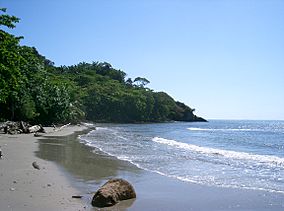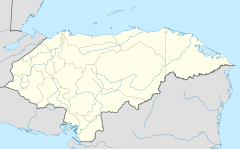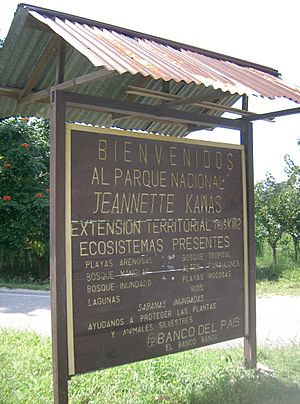Jeannette Kawas National Park facts for kids
Quick facts for kids Jeannette Kawas National Park |
|
|---|---|
|
IUCN Category II (National Park)
|
|

Punta Sal peninsula beach near entrance to the Sendero Los Curumos
|
|
| Location | Honduras |
| Area | 781.62 km2 (301.79 sq mi) |
| Established | 4 November 1994 |
| Official name: Parque Nacional Jeannette Kawas | |
| Designated: | 28 March 1995 |
| Reference #: | 722 |
Jeannette Kawas National Park (also known as Spanish: Parque Nacional Jeannette Kawas in Spanish) is a special national park found on the northern Caribbean coast of Honduras. It is located in the area of Tela, a city in the Atlántida department. This park was officially created on November 4, 1994.
The park covers a large area of about 781.62 square kilometers (which is about 301.8 square miles). Its highest point reaches 900 meters (about 2,953 feet) above sea level. A group called PROLANSATE helps manage and protect this amazing place. PROLANSATE stands for the protection of Lancetilla, Punta Sal and Texiguat, which are important areas within the park.
Contents
History of Jeannette Kawas Park
Jeannette Kawas National Park was first opened on November 4, 1994. When it was first established, it was known as Punta Sal National Park. The PROLANSATE foundation, which works to protect nature, helped create and still manages the park today.
The park's name was later changed to honor a brave environmental activist named Jeannette Kawas. She was the president of PROLANSATE and worked very hard to protect the park's natural beauty. Sadly, she lost her life on February 6, 1995, because of her efforts to keep palm plantations from harming the park. Her dedication is remembered through the park's name.
Jeannette Kawas National Park is also recognized internationally. On March 28, 1995, it was added to the Ramsar Convention List. This list includes important wetlands around the world that need special protection.
Where is Jeannette Kawas Park?
This beautiful park is located in the municipality of Tela, right on the northern Caribbean coast of the Atlántida department in Honduras. It sits between specific map coordinates, showing its exact spot on the Earth. The park covers a wide area of 781.62 square kilometers and reaches an altitude of 900 meters at its highest point.
Diverse Ecosystems of the Park
Jeannette Kawas National Park is home to many different types of natural environments. These include a mix of marine (ocean), terrestrial (land), and wetland areas. Each of these ecosystems supports a huge variety of plants and animals.
Some of the amazing ecosystems you can find here are:
- Beautiful sandy beaches
- Dense tropical forests
- Forests that are often covered in water, called inundated forests
- Important mangrove forests, which grow in salty water
- Calm lagoons
- Flowing rivers
Animals of Jeannette Kawas Park
The park is a safe home for many different animal species, from colorful birds to large mammals and fascinating marine life.
Birds
Many unique birds live in the park's forests and wetlands. Some of them are:
- Keel-billed motmot
- Turquoise-browed motmot
- Green-breasted mountain-gem
- Lovely cotinga
- Resplendent quetzal
- Bushy-crested jay
- Blue-crowned chlorophonia
- Lesser ground-cuckoo
Mammals
You can find various mammals, both on land and in the water, within the park.
- West Indian manatee (a gentle marine mammal)
- Common dolphin
- White-headed capuchin (a type of monkey)
- Howler monkey (known for its loud calls)
Fishes
The park's waters are full of different fish species.
- Tarpon
- Centropomus (also known as snook)
- Gafftopsail catfish
Reptiles
Reptiles, including some very old species, thrive in the park.
- American crocodile
- Various types of sea turtle, such as the green sea turtle, leatherback sea turtle, hawksbill turtle, and loggerhead turtle
- Green iguana
- Red-tailed boa (a type of snake)
- Mexican burrowing snake
Arthropods
Smaller creatures like arthropods also play an important role in the park's ecosystems.
- Caribbean hermit crab
- Golden silk orb-weaver (a type of spider)
Plants of Jeannette Kawas Park
The park is rich in plant life, including many unique species. Some of the plants found here are:
- Acalypha skutchii
- Cappatis truerchkhemii
- Columnea tuerckheimii
- Cordia truncatifolia
- Ormosia macrocalyx
- Phyllanthus elsiae
- Rinorea hummelii
- Salacia impressifolia
- Sida antillensis
- Sida troyana
Images for kids
See also
 In Spanish: Parque nacional Jeannette Kawas para niños
In Spanish: Parque nacional Jeannette Kawas para niños
- La Tigra National park, Honduras' first national park




